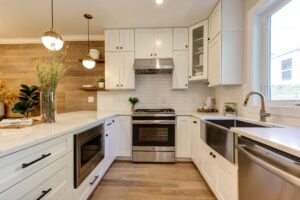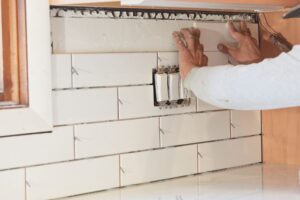A kitchen is the heart of every home, where culinary magic happens and memories are made. When it comes to remodeling your kitchen, it’s essential to pay careful attention to the layout. A well-designed kitchen layout not only enhances the overall aesthetics but also ensures functionality, efficiency, and convenience. In this blog post, we will explore various tips and considerations to help you create a functional kitchen layout during a remodel.
Assess Your Needs:
 Before diving into the remodeling process, take a moment to evaluate your needs and lifestyle. Consider factors such as the number of people using the kitchen, cooking habits, storage requirements, and any specific appliances or features you desire. This self-assessment will provide a solid foundation for designing a layout that caters to your unique requirements.
Before diving into the remodeling process, take a moment to evaluate your needs and lifestyle. Consider factors such as the number of people using the kitchen, cooking habits, storage requirements, and any specific appliances or features you desire. This self-assessment will provide a solid foundation for designing a layout that caters to your unique requirements.
The Work Triangle:
The concept of the work triangle remains a fundamental principle in kitchen design. The work triangle refers to the imaginary line connecting the three primary work areas: the refrigerator, the sink, and the cooking range. Aim to create an efficient work triangle, where each leg of the triangle is ideally between 4 and 9 feet in length. This design approach minimizes unnecessary movement, allowing for smoother workflow during meal preparation.
Kitchen Zones:
Beyond the work triangle, consider dividing your kitchen into distinct zones. This approach ensures that each zone serves a specific purpose, leading to better organization and improved functionality. Some common kitchen zones include food storage, prep area, cooking area, cleaning area, and dining or eating space. Allocate adequate space for each zone, keeping in mind the flow and ease of movement between them.
Maximizing Storage:
 Ample storage is crucial in any kitchen. During a remodel, explore various storage options to make the most of your available space. Incorporate a combination of cabinets, drawers, and pantry solutions based on your needs. Utilize vertical space by installing tall cabinets or open shelves for items used less frequently. Consider pull-out shelves, lazy Susans, and dividers to enhance accessibility and organization.
Ample storage is crucial in any kitchen. During a remodel, explore various storage options to make the most of your available space. Incorporate a combination of cabinets, drawers, and pantry solutions based on your needs. Utilize vertical space by installing tall cabinets or open shelves for items used less frequently. Consider pull-out shelves, lazy Susans, and dividers to enhance accessibility and organization.
Countertop Considerations:
Countertops are the workhorses of the kitchen, so it’s essential to choose the right materials and allocate sufficient space. Opt for durable and low-maintenance materials such as granite, quartz, or solid surface countertops. Ensure you have ample countertop space near the sink for food prep, next to the cooking range for easy access to hot pans, and near the refrigerator for unloading groceries. Having adequate countertop space allows for a clutter-free and efficient cooking experience.
Lighting and Ventilation:
Proper lighting and ventilation are often overlooked but play a significant role in creating a functional kitchen. Incorporate a mix of ambient, task, and accent lighting to provide adequate illumination for various activities. Install under-cabinet lighting to brighten work areas and consider pendant lights or recessed lighting for overall ambiance. Additionally, invest in a high-quality ventilation system to eliminate cooking odors, smoke, and excess heat, ensuring a comfortable cooking environment.
Ergonomics and Safety:
 Designing a kitchen with ergonomics and safety in mind is essential for a functional and user-friendly space. Pay attention to the heights of countertops, ensuring they are suitable for all family members. Opt for adjustable shelving and pull-out drawers to minimize bending and reaching. Install proper safety features such as slip-resistant flooring, rounded countertop edges, and childproof locks on cabinets if needed.
Designing a kitchen with ergonomics and safety in mind is essential for a functional and user-friendly space. Pay attention to the heights of countertops, ensuring they are suitable for all family members. Opt for adjustable shelving and pull-out drawers to minimize bending and reaching. Install proper safety features such as slip-resistant flooring, rounded countertop edges, and childproof locks on cabinets if needed.
Designing a functional kitchen layout during a remodel requires careful planning and consideration of your unique needs. By assessing your requirements, optimizing the work triangle, creating designated zones, maximizing storage, and prioritizing lighting, ventilation, and safety, you can create a kitchen that is both beautiful and practical. Remember that a well-designed kitchen will not only enhance your cooking experience but also increase the value and appeal of your home. So, roll up your sleeves, get creative, and transform your kitchen into a space that inspires culinary adventures and cherished memories.